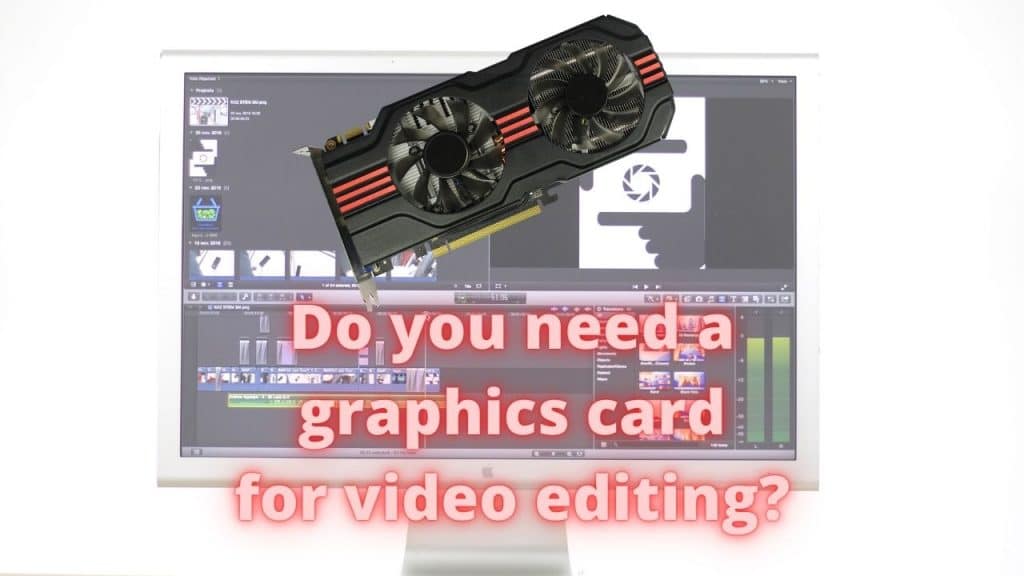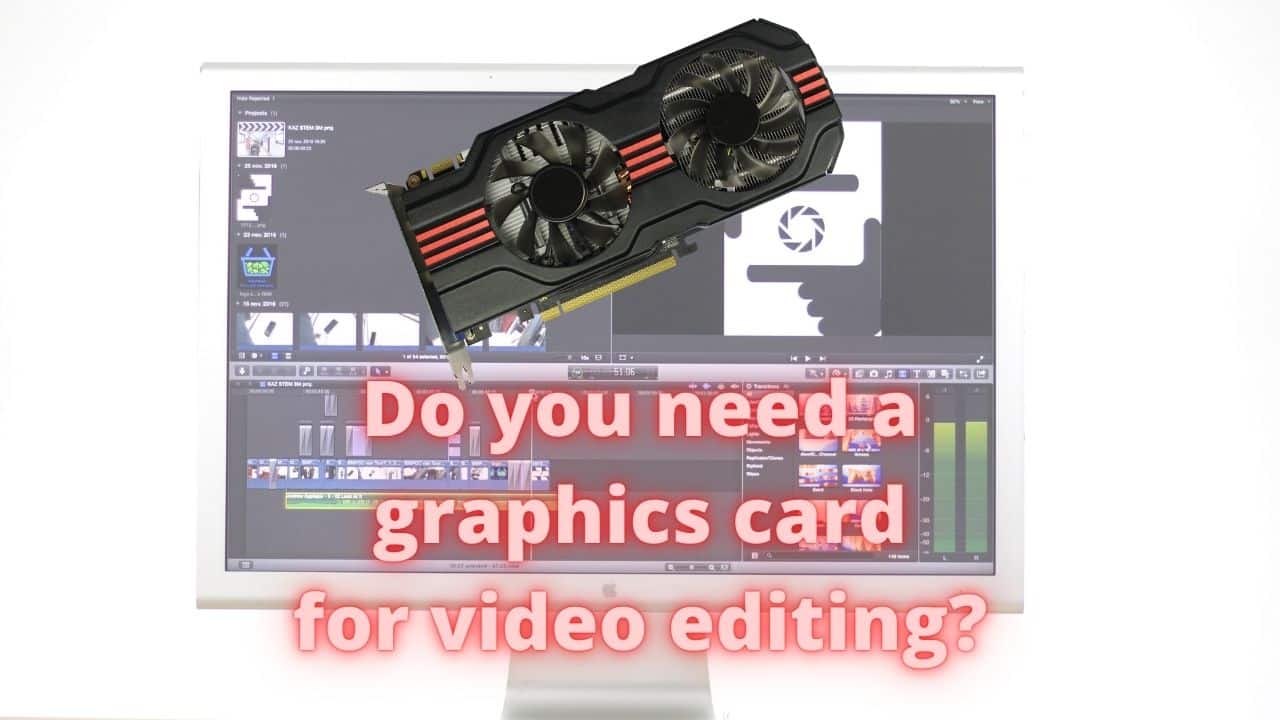Video Editing can normally be done without a graphics card. But, this is only true in some specific cases. You can edit low-quality videos using a CPU only. For example, if you record your videos using your smartphone or a basic DSLR, a 4 core CPU with up to 3 GHz frequency (with integrated graphics) can edit your videos.
Having enough RAM will also help you with editing.
With just your CPU, you can see low rendering speed and previewing problems when you are working with huge video clips.
If you want to edit 4K or 8K videos, you will definitely need a graphics card for those heavy rendering operations. There are some other reasons to go for a graphics card for video editing.
If you have a high-end camera or you have a multi-camera setup and you add all footage together in your timeline, a graphics card will make things easy and smooth for you. Also, if the editing tasks are heavy such as if you want to add a lot of effects to your videos, you will need a graphics card. You can still edit these high-end videos with a CPU if you have a powerful one. But, this will become very time-consuming for you.
In simple words, if you want to edit your videos professionally, you should go for a graphics card. For example, if you want to apply effects using some heavy LUTs, even a very strong CPU will take a time to preview it. In that situation, a graphics card will help you make things much better for you.

What is the purpose of GPU in video editing?
The main job of a GPU is to process computer graphics and images. You may get confused between a GPU and Graphics Card. But, a GPU is a small processing chip installed as a graphics card. This is actually a dedicated card with a GPU chip mounted on its surface. The GPU may also come inbuilt inside your CPU which is known as an integrated GPU.
So, the GPU works using almost similar methods as a CPU does. But, the CPUs are made to handle very complex computations. A CPU will have a less number of cores but they will be extremely powerful as compared to the GPU cores.
The GPU will generally have a lot of cores (thousands of them) but they will solve simple queries. But, because these simple queries are solved at a very high pace, the GPU has got an application in graphics-related tasks. Especially the repetitive tasks are performance pretty effectively with the GPUs.
When it comes to video editing, a GPU will help making video decoding pretty easy for you. So, when it comes to rendering the editing files or previewing the timeline videos, a graphics card is going to allow you to make things pretty easy for you.
Definitely, there are numerous roles of CPUs as well when it comes to video editing. So, if you have a powerful CPU with 6, 8, or more cores, you can easily edit high-resolution videos with it as well. However, when you are going to edit videos professionally at a higher resolution, a GPU is the primary requirement for you because it has a better capability to process those repetitive data sets.
Do all video editors need a dedicated graphics card?
If your videos are recorded at a higher resolution (more than 1080P), you will generally have to go for a graphics card to make things easier for you. However, if the resolution is low and the length of videos is small, you are good to work with a CPU as well. Make sure to have a CPU with a good frequency and at least 4 cores as we discussed earlier.
If you are a YouTuber who edits videos regularly, a graphics card will make your workflow fast and efficient. Also, if you are a professional editor who work with multiple timelines and add a lot of effects, a graphics card is crucial for you.
But, if you are learning video editing or your videos are recorded in a lower resolution, there is no need to spend a lot of money on a graphics card. You can upgrade it later.
How will a graphics card improve your editing experience?
- First of all, importing video files to your editing software will become faster
- The video previewing will be smooth even at the higher resolutions
- Adding heavy LUTs will be easy
- Adding transitions, music, and other components will not take a lot of time
- Rendering will be very fast
In a nutshell, a graphics card is a primary requirement for a good editing experience. But, on the other hand, it is not the most important thing you will need to edit your videos. You can still edit your videos without a dedicated graphics card.
The basic job of a GPU is to help the CPU with the rendering and graphics processing tasks. You might be using any video editing software such as After Effects, Premiere Pro, DaVinci Resolve, etc, a GPU will come to its job when you have the suitable task ready for it.
So, the GPU will free up your CPU to handle some other tasks which are not related specifically to these algorithm calculations.
Again, there are a lot of people who use their CPUs and integrated graphics to edit videos professionally. Obviously, you will have to spend some extra time and handle some frustration as well. But, it is not impossible to edit videos without a dedicated graphics card.
How much VRAM is good for video editing?
The purpose of VRAM inside a graphics card is to hold the graphics data till the time it is waiting for the GPU to get processed. So, the more the amount of VRAM, the more data your graphics card can hold. So, a good amount of VRAM can only be determined by the type of videos you want to edit.
Obviously, we need more VRAM to hold the data of 4K video as compared to a 720P video of the same length. But, there is a general rule to choosing the right kind of graphics card VRAM for video editing.
| Video Type | Suitable VRAM | Suitable Graphics Card |
|---|---|---|
| 1080P/2160P (FHD Timeline) | 6-8 GB | RTX 2060, RTX 2070, etc |
| 4K Footage (QHD Timeline) | 8-11 GB | RTX 2080, RTX 3080Ti, etc |
| 4K+ Footage (4K Timeline) | 16-24 GB | RTX 3090, RTX 6000, etc |
The speed of VRAM is another important factor here. I am considering the at least DDR4 VRAM here while suggesting you the amount. if you want to go for the best of all, you should definitely go for the RTX 3090 or RTX 6000 graphics card.
How to choose the right graphics card for video editing?
There is no direct answer to this question because the selection of your graphics card will firstly depend on the CPU and your overall system specifications.
The next step is to go to the official website of your desired video editing software and check the system requirements there. There, you will find the information about what kind of graphics specifications you need for that software.
Generally, you should have at least 2 to 4 GB of VRAM on your graphics card for 1080P video editing. 4K video editing will generally require 6 GB of VRAM.
If we talk about the GPU cores, the more is the better. However, even a low-end graphics card combined with an average CPU can help you perfectly with professional video editing pretty easily. I have found a great YouTube video from FilterGrade to help you know the basics of graphics card selection for video editing.
Integrated GPU vs Dedicated GPU: Which one to choose for video editing?
A dedicated GPU is definitely a good option to choose when you have limited bugets to spend on your system build. There are numerous CPUs from both Intel and AMD that comes with the dedicated graphics cards. So, the 1080P videos and especially the short duration videos can easily be edited without having to use a dedicated graphics card.
The dedicated graphics cards are good for long videos and especially the high-resolution videos. So, if you are going to edit 4K videos or even the 1080P videos with multiple cameras, you should go for a dedicated graphics card.
You can firstly check if your CPU is giving you the desired results. If you see that the performance is not up to the mark, then its the time to upgrade to a dedicated graphics card.
Frequently Asked Questions
There is little to no benefits of having a powerful GPU in terms of final exporting. A good CPU is going to help with the same.
Yes, a good graphics card with enough VRAM as per the video resolution along with the suitable cores and frequency will help you fasten up the rendering tasks.
Thanks for reading!

I am Anshul Rana, an experienced author specializing in PC gear reviews and Windows 10 software tutorials. With a strong passion for technology and an in-depth understanding of the PC industry, I provide insightful and detailed analyses of computer peripherals, gaming gear, and software solutions. My writing style is concise yet informative, making complex topics accessible to both beginners and advanced users. Through my reviews and tutorials, I aim to offer valuable guidance, helping readers make informed decisions to enhance their PC experience and explore the vast possibilities of Windows 10 software.










